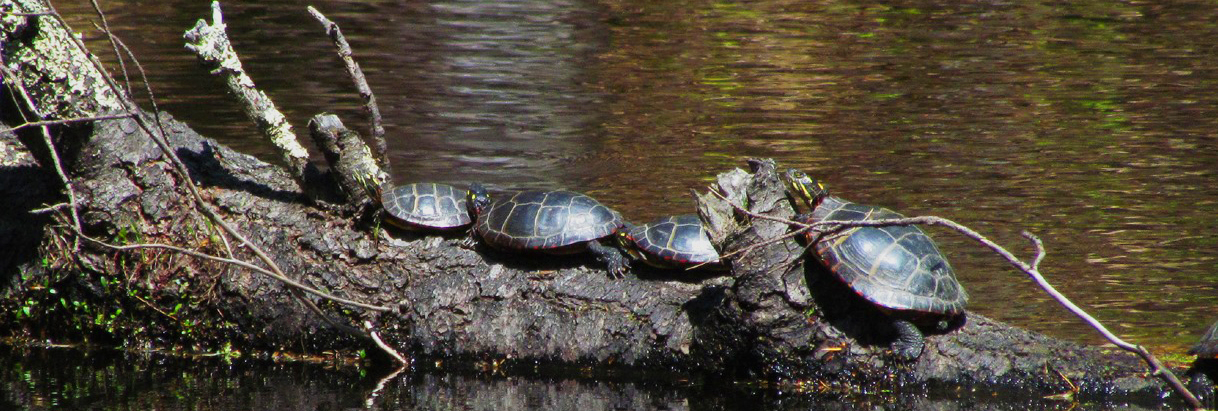Lesson 4: FIELD TRIP STOPPING ALONG THE LAMPREY
Overview:
This lesson focuses on taking children to the Lamprey River and allowing them to experience the river from a number of different locations. Included in the lesson are suggestions for completing several field studies that allow students to build and use a variety of monitoring tools to measure physical, chemical, and biological properties of the river.
Learning Objectives:
Students will be able to
- enhance their understanding of the river and its watershed;
- build monitoring tools for use on the Lamprey River;
- use monitoring tools appropriately to sample basic parameters of water;
- collect samples and make observations of animal and plant life along the river.
Materials for Each Class:
__bus or transportation
__permission slips
__first aid kit
__name tags for everyone (including chaperones)
__moistened towelettes to clean hands
__4 plastic containers with covers for water samples
___nets or strainers
__Ziploc bags (large and small) for leaf, rock, and soil samples
__pencils and pencil sharpeners
__clipboards for attaching data sheets
__dissolved oxygen kit and bucket with rope attached to the handle for collecting water
__pH kit
__measuring rope for current measurement
__bag of apples
__stop watch
__thermometers
__discover scopes (optional)
__markers (permanent) to label bags
__laminated map of the Lamprey River watershed
__data collection sheets
__global positioning system instrument (optional)
__appropriate monitoring tools (see individual lists for each activity)
__binoculars
__field guides for trees, plants, insects, birds, etc.
__laminated experiment sheets
__cell phone (optional, but very handy in case of emergency)
Procedure:
1. Select the sites for the field trip and visit them before taking the students on the trip. Time how long it takes to get from one location to another and remember that it generally takes about 5 minutes to load and unload buses with passengers. Be sure that you have written accurate directions for the bus driver.
2. At a minimum, classes should view the headwaters of the Lamprey at Betty Meadows in Northwood, and the closest point accessible to the end of the Lamprey River in Newmarket, at Heron Park. These sites, plus additional sites are listed in "Notes for the Teacher" at the end of this lesson. Teachers are urged to seek out safe, interesting points in their own towns and visit them to check for suitability and safety before taking their students there.
3. Inform the town offices that control sites where you might be visiting. Make arrangements for gates to be opened if necessary. Sometimes local conservation commissions can put you in touch with people in the community who can act as naturalists for your field trip.
4. Plan for bathroom and lunch stops along the way.
5. Arrange for transportation to chosen sites for the field trip. Often the bus can be provided free of charge if you plan your trip within the time limits that the bus will be available to the school.
6. Contact parents and other community people to act as group leaders for student research teams. One adult for every 3-4 children is a good ratio. Prepare a written field trip schedule for them and be sure they understand what they are to do on the trip. If possible, invite them in to assist the students when they are practicing their field trip experiments in class. It may also be useful to invite them to view the DVD with the students as preparation for the field experience.
7. Review information about the river, goals, and instructions before the field trip. Be sure the students know what group they will be in and who their chaperone will be.
8. Upon arrival at a site, have everyone gather together to hear a short site description, a review of safety measures, and purpose of observations and experiments at that particular site. After, have them get into their groups before going to the location.
9. Important: follow up the field trip with classroom activities that involve identifying and classifying specimens, using microscopes to look at water samples, using magnifying glasses to look at soil samples, etc. Use the data sheet records or other notes taken on the field trip to add information to the charts and watershed map created in previous lessons. Discuss relationships between plants and animals and the environment. Invite chaperones to assist the students in class. Chaperones are often interested in coming to the classroom to help with follow-up activities.
FIELD TRIP SUGGESTIONS
Explore the Lamprey River: This popular guide was originally printed in 2008 and updated in 2020. The area of focus covers the Wild and Scenic towns of Epping, Lee, Durham, and Newmarket. Hard copies are available at town libraries, town fairs, and by request here.
Other suitable areas:
Northwood Meadows State Park (headwaters at Betty Meadows)
Freese's Pond---Deerfield * (The elementary school is very near this location.)
Lamprey River El. School---Raymond * (with permission of the school)
Foss Farm---Durham *
Sliding Rock Park---Newmarket

